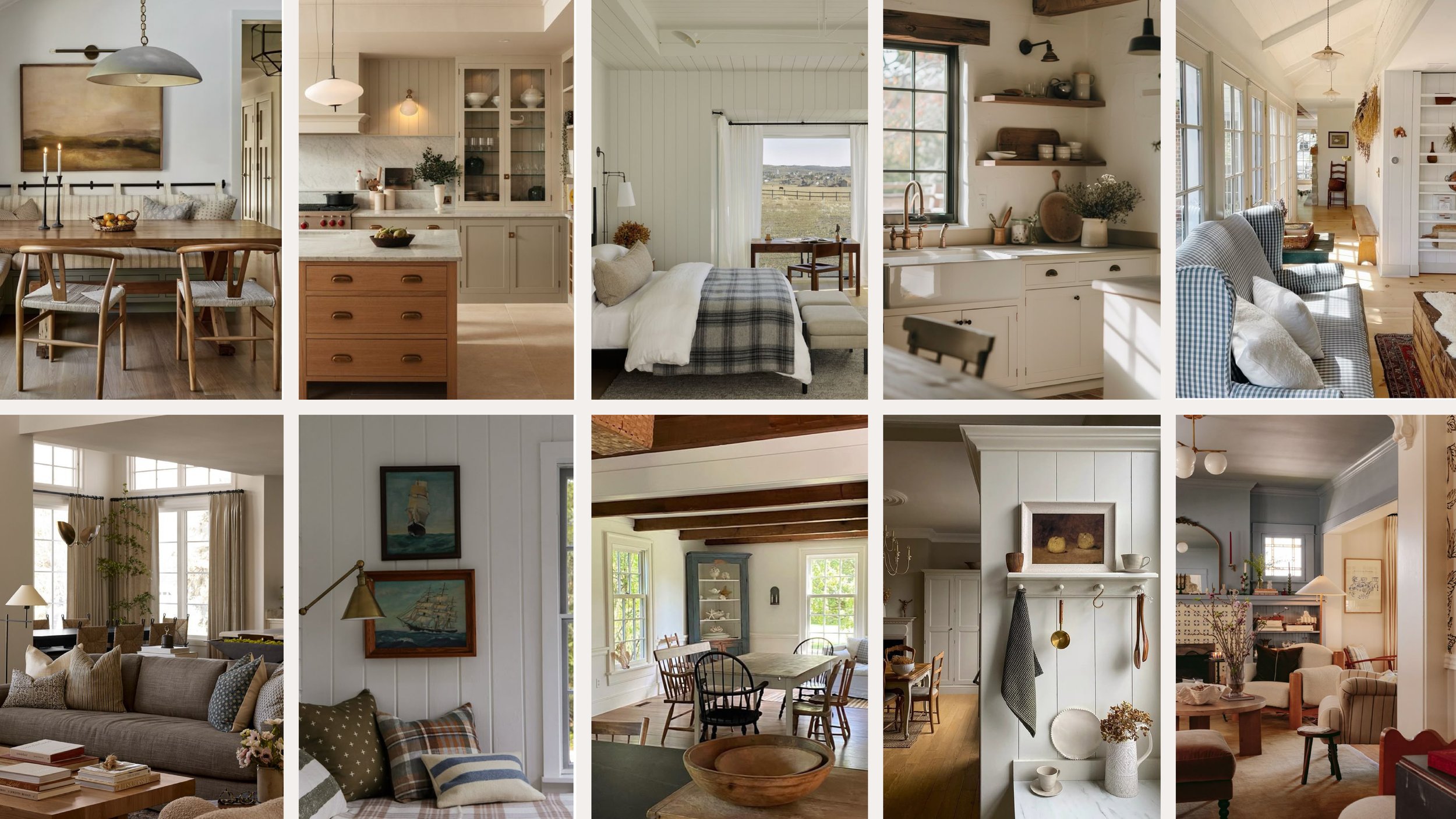
These interior style concepts naturally complement a wide range of exterior styles. By definition providing a transition between traditional and contemporary style ideas; these styles offer a more relaxed way of conveying traditional narratives.
Classic
Best Suited For These Exterior Style: Eclectic, Post-Victorian, Ranch, Suburban, New-Traditional
Imagine: Polished nickel or unlacquered brass, plush sofas with rolled arms and piped cushions, upholstered headboards and quilted comforters, stately tones on well-crafted millwork, marble countertops and classic subway tiles.
A blend of traditional and modern styles; classic style offers a balanced and timeless look that is adaptable to many architectural styles. Key features include:
Neutral colour palettes.
Integration of functionally inclusive spaces (i.e. kitchen and dining).
A mix of furniture with clean lines and traditional details (70% new, 30% vintage).
Layered textures using rugs, throws, and upholstery.
Modern style built-in cabinetry.
Paired down decor and trim.
This is a popular and safe bet. They are comfortable and approachable. Adaptable to almost any style of home but particularly effective in post war styles. The balance between traditional and modern style can be dialed in to the right fit for the architectural style.
Farmhouse
Best Suited For THESE EXTERIOR STYLES: Folk, Rural Gothic, Ranch, New-Traditional
Imagine: A creamy apron sink, open working kitchen, preserves in the pantry, sturdy wooden chairs around a time-worn table, chore coats on pegs above rain boots in the mudroom, roughed-up wide plank floors, gooseneck sconces and enamelled pendants lighting halls, old benches, and baskets of wool blankets.
Popularized by its warm and welcoming, family friendly charm, farmhouse style incorporates:
Shiplap walls, sliding barn doors, and open shelving.
Neutral tones.
Mix-and-match furniture, with a well used look.
Collected homestead décor.
Farmhouse is a variation of transitional style. It is best applied to houses in a country setting where the farmhouse concept is believable. This style works best with Revival, vintage and new traditional architecture. Careful adaptation to revival and vintage styles can result in a timeless, hybrid interior.
Coastal
Best Suited For These exterior styles: Mid-Century, Ranch, Suburban, New-Traditional, Modern
Imagine: White ship lap walls and ceilings, soothing blues and soft green hues, rattan and woven wicker furniture, easy-going linen upholstery, windows that frame scenic views, nautically inspired lighting, round mirrors and jute rugs.
Coastal design reflects a breezy, seaside aesthetic. Key features include:
Light and airy colour schemes inspired by coastal landscapes.
Natural materials like rattan, wicker, and driftwood.
Nautical décor.
A focus on maximizing natural light and views.
Coastal is a variation of transitional style. This is a great style choice for coastal homes of any vintage where the relaxed styling complements the surroundings. The decor and material choices are optimized in this case to reflect the coastal setting.
-
-This guide provides a brief, highly graphical overview of Canada's architectural heritage, highlighting the defining characteristics of various building styles and types across different historical periods. We love older Parks Canada publications.
Parks Canada. Buildings of Canada: A Guide to Styles and Types. 1980, https://www.historicplaces.ca/media/7173/buildingsofcanada.pdf.
-This guide, commissioned by an East coast municipality, is quite comprehensive. It provides more detailed information on the architectural styles that are common in Canada.
Town of Sackville. Heritage Architecture Style Guide. 10 Mar. 2014, https://sackville.com/wp-content/uploads/2016/01/Heritage_Architecture_Style_Guide_Final_10March2014.pdf.
-This book provides a comprehensive overview of major architectural styles and building terminology in Ontario from the late 18th century to relatively modern times.
Blumenson, John J.-G. Ontario Architecture: A Guide to Styles and Building Terms, 1784 to the Present. Fitzhenry & Whiteside, 1990.
-A concise introduction to considering the architectural character of your home is provided in the U.S. Department of the Interior National Park Service Cultural Resources - Preservation Guides. The National Park Service preservation guides are a great resource in general and well worth exploring.
-This book outlines what to look for, what to do and what not to do when working on important building details.
Cusato, Marianne, and Ben Pentreath. Get Your House Right: Architectural Elements to Use & Avoid. Sterling, 2007.
-This book provides an excellent detailed guide to American residential architecture (basically the same as Canadian architecture).
McAlester, Virginia Savage. A Field Guide to American Houses (Revised): The Definitive Guide to Identifying and Understanding America's Domestic Architecture. Knopf, 2015.
-This book provides detailed information on building elements.
Benjamin, Asher. The American Builder's Companion. Illustrated ed., Feb. 26, 2009, Dover Publications.
-This book provides detailed information on building elements indicating scale and proportion.
Radford, William A., Bernard L. Johnson, and Charles P. Rawson. Radford's Portfolio of Details of Building Construction: A Remarkable and Unique Collection of Full-Page Plates, Accurately Drawn and Reproduced to Exact Scale. Complete Details for Every Style of Interior Trim, Including Special Built-In Features. Illustrated ed., Dover Publications, Aug. 31, 2012.
Copyright Disclaimer: This online resource is for informational purposes only. All content is protected by copyright law and may not be reproduced, distributed, or used for commercial purposes without permission.

